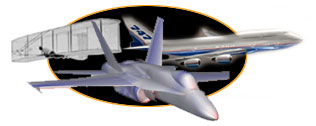|

Conference
and Webcast Information
Pre-Conference Activities
Post-Conference Activities
Home |
Background Information
Links:
- The Beginner's Guide to
Aerodynamics is a NASA-developed educational site with interactive
simulations. The site allows students to learn how airplanes fly,
including the forces that lift them off the ground, keep them in the
air, and help them land.
- Follow the
Wright Brother's invention process, learn about the development of
early flight, and find educational materials and lesson plans at Re-Living The Wright Way
- Control Surfaces
are moving parts that control the motion of an aircraft in flight.
To learn more about flight control, take this guided
tour by following the Control Surfaces links at the
bottom of each page.
- Powerpoint
file of the Graphics used in the show. Html
Version - Source
File
NASA
Education Links:
- Spacelink
is a NASA search engine that can be used by teachers and students to
find information, lesson plans, or educational materials related to
space, science, math, and engineering.
- The Learning Technologies Project helps
integrate NASA research and technology into the K-14 curriculum through
web-based resources, computer simulations, and videoconferences.
- The mission of
the Office of Educational
Programs at NASA Glenn Research Center is to use NASA's inspiring
missions, laboratories, and diverse and specialized workforce to provide
appropriate educational programs and activities and to enhance the teaching
and learning of science, mathematics, and technology.
- One of the major
breakthroughs of the Wright brothers was the ability to control and
maneuver their aircraft. Roll control was provided by a unique idea
called wing warping. The tips of their wings could be twisted
relative to the rest of the wing by a series of cables. Experiment with
wing warping mechanics and the forces that affect flight using an educational
computer simulation at http://wright.nasa.gov/airplane/warp.html.
Related
Links:
-
For his historic
first flight on December 17, 1903, Orville Wright used the movements
of his hips in the airplane’s “saddle”—in which he lay prone—to twist
or warp either the left or right wing tip. This provided flight control
without the use of ailerons or flaps. The active
aeroelastic wing (AAW) aircraft is taking an element of the Wright
brothers’ original aircraft, a feature deliberately engineered out
of modern planes, and reincorporating it.
-
For information
on constructing or flying remote-controlled aircraft, visit The
Academy of Model Aeronautics, a national association for the builders
and flyers of model aircraft.
Educational
Standards :
- Standards
- Access information on National Standards associated with the LTP educational
web pages.
|



